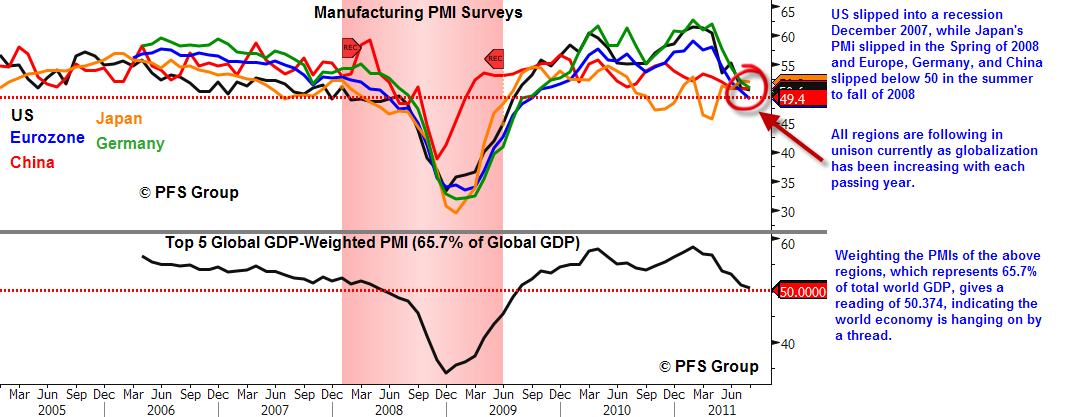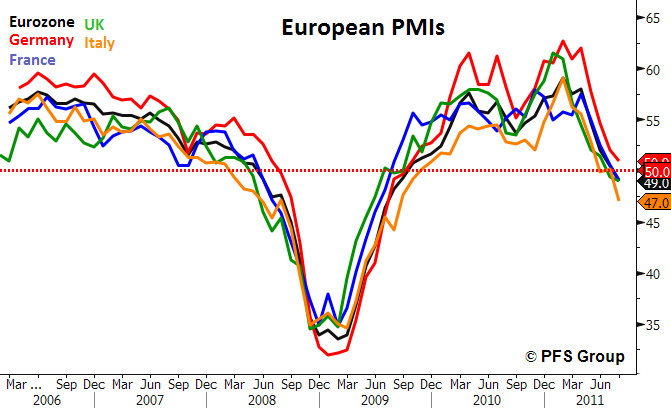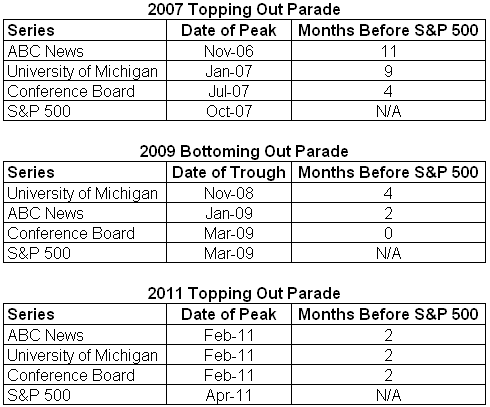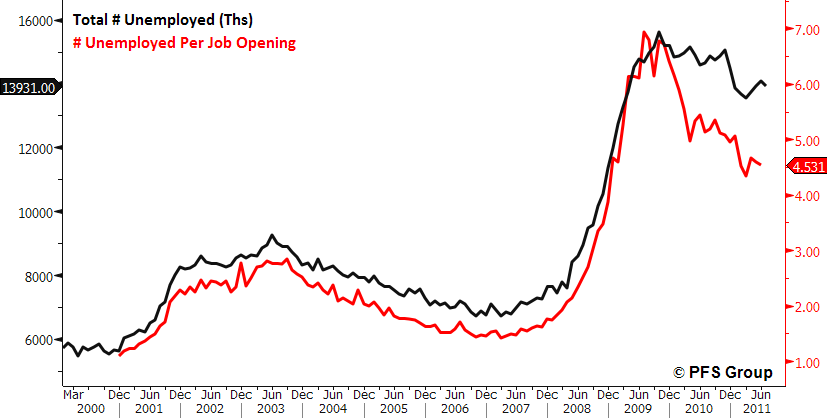It’s not just the U.S. economy that is throttling growth back to stall speed but the global economy as a whole. One of the most powerful big picture concepts that has taken place over the last decade is globalization, the interconnectedness of the world economy, and right now it's skating on thin ice. While the U.S. may have been the fire starter with its subprime crisis back in 2007-2008, this time it may be the Euro crisis that pulls the global economy underwater. The heart of the matter in the Eurozone and other developed economies is too much debt relative to their productive output—a situation set to intensify as a slowdown in growth (shrinking economies) exacerbates the debt to gross domestic product (GDP) ratios as it becomes more difficult to service debt with shrinking revenue.
You Go, I Go, We all Go
As mentioned in the opening paragraph, investors and economists cannot look at the U.S. in isolation as globalization has become a dominant theme over the last decade. For the past two years corporations have had record earnings with a large portion of revenue coming from overseas, also partly explaining why U.S. markets have performed so well despite this being one of the worst recoveries since the Great Depression. Large-cap blue chip names are benefitting from globalization as they are increasing exposure towards faster growing foreign markets.
That said, globalization is also a double-edged sword. As you can see from the figure below, starting from the early 2000s many global economies started to synchronize, minimizing the previous benefits of diversifying their corporate revenue bases geographically to shield from regional downturns. Now, the leading economic indicators calculated by the OECD for various regions and countries show we currently have an economic slowdown where everyone is getting dragged over a cliff.
As highlighted in my last article (“If You Thought August Was Bad, Just Wait Until September!”), a number of major upcoming economic releases were likely to disappoint, and a U.S. jobs report for August that showed zero job growth is testament to that. However, we did not just have a disappointing economic showing this week domestically, but also worldwide. While the U.S. manufacturing PMI (ISM report) showed the manufacturing base of the country expanding marginally (>50) with a 50.6 reading, we had disappointing PMI readings for August from China and parts of Europe. This can be seen in the figure below for various regions which shows the top five global economies are either in contraction (<50) or just marginally expanding. The bottom panel below is a global GDP-weighted PMI for the world’s top five economies (shown individually in top panel) which represents two thirds of global GDP. The top 5 PMI peaked in February at 58.37 and has steadily declined all year to a reading of 50.37 in August, which shows global GDP skating on thin ice and likely to slip into contractionary territory by next month for the first time since June 2008.
What we are witnessing is the negative side effect of global economic synchronization, where when one country slips into a recession more are likely to follow as the global supply chain becomes more and more intertwined. Thus, the “if you go, I go, we all go” theme comes into play more than ever before.
Eurozone Economic Contraction Set to Add More Fuel to Euro Crisis Fire
As mentioned above, the Eurozone debt crisis is spilling over into the global markets just as the U.S. subprime fiasco infected the global financial markets in 2008. The PMI for the Eurozone came in for August at 49 which places it in contractionary territory for the first time since June 2008. This is hugely significant since any debt problem only becomes exacerbated by a recession as the revenue needed to service the debt declines during recessions and magnifies debt-to-GDP ratios.
Perhaps most disturbing this week was news that the world’s 8th biggest economy, Italy, saw its August PMI fall to 47 as it moves also deeper into an economic contraction. Equally disturbing this week was news that the growth juggernaut of the Eurozone, Germany, which also happens to be the world’s fourth largest economy, saw its PMI fall to 50.9. The August reading for Germany puts it basically at stall speed and represented the worst reading in two years. The worse Germany’s economy gets the less German citizens will be willing to bail out the fiscally irresponsible periphery nations of the Eurozone like Greece.
Zeroing in on Italy, its PMI falling into contraction territory is particularly troubling given Italy is third in the world behind the U.S. and Japan for outstanding government debt, and falling tax revenues from a shrinking economy will only exacerbate their debt woes and also lead to further stress for world financial markets. Bloomberg economist David Powell presents a troubling picture for Italy and the world economy, with excerpts from his recent articles provided below.
Italy May Be to the World Economy as Greece is to the Euro
In late 2009, when investors around the world started to focus on the fiscal woes in Greece, whose economy makes up only three percent of output in the euro area, the budding crisis threatened to derail the monetary union’s recovery. Italy, which represents about only 2.5 percent of global output, may play a similar role for the world economy.
The European sovereign debt crisis is showing signs of flaring up again, with the reprieve created by the European Central Bank’s renewed purchases of government bonds in August looking like it will be just as temporary as in the past. The spread between the 10-year sovereign yields of Italy and Germany rose by 9 basis points on Thursday and has increased by 14 basis points since Monday. The equivalent for Spanish bonds increased by 8 basis points on Thursday and has risen by 11 basis points since the start of the week.
The dismal PMI readings were the immediate catalyst for the rise in yields yesterday, though the amendments to the latest fiscal austerity package announced by Prime Minister Silvio Berlusconi this week are probably contributing to the rise in financing costs as well.
David Powell
Bloomberg Economics Brief (09/02/2011)
Berlusconi’s Backpedaling May Push Italy Back Toward The Brink of Disaster
Italian Prime Minister Silvio Berlusconi may be steering his country back toward the eye of the sovereign-debt crisis storm as he tests the European Central Bank’s commitment to saving the Mediterranean country from a full-blown economic and financial crisis.Berlusconi, responding to domestic opposition, said on Tuesday that a previously announced 45 billion euro austerity package, which may have swayed the European Central Bank to buy Italy’s government bonds, will be pruned…The reduction of the austerity package will probably leave the ECB’s Governing Council even less inclined to buy Italian government debt as it attempts to cut its overall level of bond purchases from the 22 billion euros acquired during the week ended Aug. 12, after the 10-year Italian sovereign yield reached 6.2 percent…Italy can ill afford to test the ECB’s commitment as the country prepares for a serious test of its ability to continue accessing financial markets in September, when it will need to refinance 46 billion euros of maturing bonds. That is about six times the amount successfully raised by the Italian Treasury on Tuesday. Berlusconi may soon regret his backpedaling on austerity.David Powell
Bloomberg Economics Brief (08/31/2011)
Focus on Worlds Biggest Economy Paints a Troubling PictureHighlighted above was the precarious state of the Eurozone which represents the worlds’ second biggest economic zone. The world’s largest economy, the U.S., is in no better position. Last week's article highlighted the horrible consumer confidence readings we received from the Michigan Consumer Sentiment report. Some readers were quick to point out that the present reading is often associated with market bottoms and that means we were presented with a buying opportunity in the stock market. Nothing could be further from the truth as the devil is always in the details.
While it is true that present readings are near recessionary trough levels that often mark stock market bottoms, a closer look at the data is warranted. Looking at both the Michigan Consumer Sentiment and the Conference Board’s Consumer Confidence Index shows that the peak for the present cycle was the lowest peak on record. While present levels are near prior recessionary lows, those prior lows occurred after falling from significantly higher levels where the lows were made in deep negative year-over-year (YOY) territory. Simply stated, you can’t just look at the absolute data, you also need to look at its momentum, or more specifically, the rate of change in the data.
Shown below is the Conference Board’s Consumer Confidence Index with the one month change in the middle panel and the YOY change in the bottom panel. The one-month decline of 14.7 points for August was one of the worst declines on record. Most importantly, we have only seen eight other readings of a monthly decline of that magnitude and we’ve been in or about to fall into a recession in seven of those cases. Looking at the YOY decline shows a decline of -16.35% for August, with only eight other occurrences of a decline of that magnitude occurring before, with seven of those occurring during or just before a recession.
Other readers of my article from last week also made the claim that consumer confidence is a lagging indicator, the facts say otherwise. Looking at both the major turns in the last business cycle show the opposite in which consumer confidence reports peaked prior to the S&P 500 in 2007 and bottomed before or coincidently with the market in March 2009. This go-around they also peaked before the stock market did and thus act as a better leading indicator of future economic growth than the stock market. Below is a table of the 2007 peak, 2009 bottom, and the present 2011 peak in sentiment and the stock market. As you can see, investors would be better served tracking consumer confidence levels for their investing decisions than taking their cue from the stock market.
Turning now towards the horrible jobs data, what is particularly worrisome is that monthly job payrolls have come to a standstill and look set to contract in the months ahead, which will only worsen the swollen unemployed ranks. The U.S. has nearly 14 million workers unemployed and given the number of job openings present shows more than four people unemployed per every job opening, not an encouraging picture particularly if businesses retrench and the number of unemployed picks up again.
The dismal jobs report for August which showed zero jobs created is putting the U.S. economy at serious risk of a recession as the following CNN Money article points out (emphasis added):
With zero jobs, recession risk just got worseAs if Friday's report that showed job creation at a dead stall wasn't bad enough, economists say the worst could be yet to come.That's because high unemployment could be a warning sign -- and the cause -- of the country falling into a double dip recession.Most economists weren't ready to call a new recession yet. But many were raising the odds of one.They're worried because weakness in the labor market can lead businesses and households to pullback on spending. And that is the worst thing possible for an economy where overall growth has slowed to nearly zero."When employment drops, incomes fall. When income falls, sales fall. When sales fall, production falls. When production falls, employment falls," said Lakshman Achuthan, managing director of Economic Cycle Research Institute.It's a tough cycle to break."You can scream and shout, you can be the President, you can be the Congress, you can be the central bank, you're not going to stop that once it gets going," said Achuthan.The risk of a pullback in hiring by businesses is real and the service economy in the U.S. is at serious risk. Bloomberg’s Orange Book is a collection of company earnings calls and the message from the U.S. CEOs is not encouraging as the Book’s main findings below illustrates:
Bloomberg Orange Book (09/02/2011)A growing lack of confidence is the most cited issue by consumer-related companies in the Orange Book this week. Footwear, apparel, food & beverage, and grocery stores are all concerned about the challenges faced by would-be shoppers and are subsequently discounting sales expectations. Restaurants appear to be among the most troubled.
“The Business Cycle is More Powerful” Than PolicyAs Lakshman Achuthan, managing director of the Economic Cycle Research Institute (ECRI), highlighted in the CNN Money article above, what we have right now is the business cycle negative feedback loop kicking in to full gear and “you’re not going to stop that once it gets going.” The reason for that is fiscal policy occurs with a major lag and it can certainly help the medium to long-term economic outlook, but not in the short term. Lakshman made the argument earlier in the week on Yahoo Finance (“No Near-Term Jobs Fix”) and also in a Bloomberg interview (“ECRI’s Achuthan on U.S. Employment Report, Economy”) today in which he said “the business cycle is more powerful” than policy.
ECI's Achuthan on U.S. Employment Report, EconomyYou’re getting a feedback loop and that’s not something that you can have a policy announcement and say ‘stop the feedback loop.’ You can’t do that, the business cycle is more powerful.”The overriding message is defense and capital preservation. I continue to feel the U.S., and the global economy for that matter, is at serious risk of falling into a recession and given the negative economic momentum there is likely little monetary or fiscal policy can do in the short run to improve the economy. That said, the worsening picture is certainly likely to bring forth a monetary (QE3 at next FOMC meeting) and fiscal response (Obama job stimulus announcement next week) with another round of QE from the Fed to lift the stock market and risk assets. However, there is no mistaking that global growth is falling and it will take time for stimulus from both areas to feed back into the economy. Not to mention, we are still at high risk of seeing major banking crises in Europe that could really throw a monkey wrench in economic growth, and why investors should continue to remain defensive. Now is not the time to play the hero.
For a greater discussion on many of the topics raised in this article, feel free to read these below:
08/26/2011 If You Thought August Was Bad, Just Wait Until September!
08/19/2011 Bernanke’s Worst Nightmare
08/12/2011 Economic Indicators Show Recession As Early As Next Month
08/05/2011 The Bears Are Now In Control
06/24/2011 Global Monetary Tightening Taking Its Toll, Risks Mount
05/13/2011 Why Bill Gross is Wrong...In the Short Term












